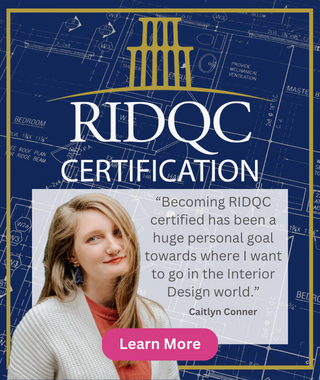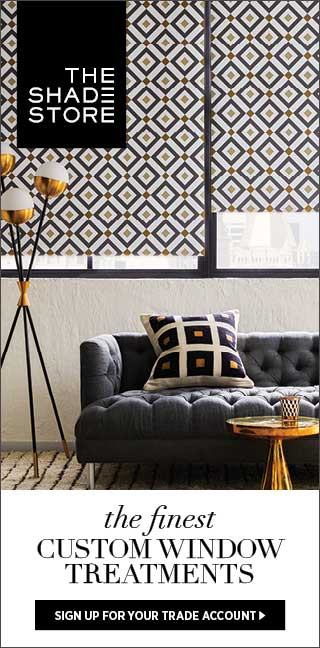Revolutionary Architect Meets Classic-Modern Designer
Classic Meets Modern: Meet Paloma Contreras
“I love classic beauty. It’s an idea of beauty with no standard.”–Karl Lagerfeld, Fashion Designer
 We’ve all said it or seen it written somewhere that classics never die, and it’s totally true! We see that each and every day in our interior design practices. Oftentimes, when we can’t figure out how to best create a new space, we go back to the classics—How would Dorothy Draper, Mark Hampton or Albert Hadley have done this?
We’ve all said it or seen it written somewhere that classics never die, and it’s totally true! We see that each and every day in our interior design practices. Oftentimes, when we can’t figure out how to best create a new space, we go back to the classics—How would Dorothy Draper, Mark Hampton or Albert Hadley have done this?
But we also know that we can’t be stuck in the past and hang all our laurels on the past (aka classics). It’s important that we evolve what we love and what we see as trending in our industry, and we identify what makes our creations truly ours.
This may be where the likes of interior designers like Paloma Contreras of Paloma Contreras Design in Houston may be of some help. In her work, she’s learned that the classic design styles she has long loved must also be implemented in the modern-day styles she creates for clients.
It’s also something she’s writing about! Her new book, “The New Classic Home, a Modern Take on Traditional Interiors,” is beautiful, inspiring and would be the perfect holiday gift.
“It’s essentially an extension of my first book, ‘Dream, Design, Live,’ in which we take a deeper dive into the concept of bridging the gap between the seemingly more modern elements and those that are super classic to create a home that feels both timeless, but of the moment,” Contreras shares. “We talk a lot about how to achieve that.”
Get to know more about Contreras her path to success below in this month’s newsletter!
Some Thoughts On … Column
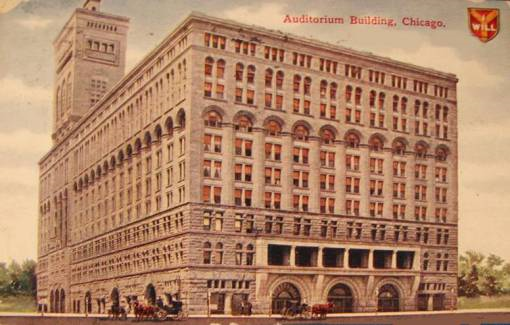
In Carl Dellatore’s second column for DSA, he is sharing his insights on famed architect Louis Sullivan, who he believes influences our industry as we know it today.
“His innovative ideas and groundbreaking contributions reshaped American cities’ skyline and laid the foundation for modern architectural principles,” he writes in his newest column, which you can check out below.
The Auditorium Building was the largest in the world at the time, and helped put Sullivan on the map.
Partnership Announcement - Coming soon!
DSA and Mydoma have committed to this collaboration in an effort to support the professional journeys of both students and established designers, providing them with a platform to manage and grow their businesses successfully.
Mydoma is a premier platform that offers comprehensive business management solutions for interior designers. Beyond being a software, Mydoma is here to help designers at all stages of their professional journey. This new software empowers designers to spend less time managing and more time creating.

Professional Designers
Exclusive Benefits for DSA Professional Members: Click for more information on what the tools can do for your business. From professional presentations to invoicing, the platform will elevate client interactions and improve your business.
DSA members receive a personalized onboarding call to integrate Mydoma's comprehensive toolset seamlessly into their workflow. Additionally, a discount of $100 on their Professional Annual Plan subscription!
Student members - Coming in November
Under this partnership, DSA students embarking on their design careers can enjoy complimentary membership access to Mydoma's platform throughout their study period. Students will receive links for the opportunity through their learning institutions. If you are not attending a participating school, you can purchase at a dramatically reduced cost to enhance your student learning experience.
Be on the lookout for further updates!
Some Thoughts on Louis Sullivan.jpg)
By Carl J. Dellatore
I would argue that Louis Sullivan’s ideas influence interior design as we know it today. But I’m ahead of myself. Let me explain.
You likely know Sullivan’s work. He is hailed as the "father of modern architecture," leaving an indelible mark on the design and construction world and influencing architects and designers today. His innovative ideas and groundbreaking contributions reshaped American cities’ skyline and laid the foundation for modern architectural principles.
Born on September 3, 1856, in Boston, Massachusetts, Louis Sullivan displayed a remarkable aptitude for drawing and design from a very young age. His early exposure to architecture and art laid the groundwork for his future accomplishments. His journey into architecture began with formal training at the Massachusetts Institute of Technology and the École des Beaux-Arts in Paris, where he honed his skills and absorbed architectural traditions.
Sullivan's breakthrough came when he joined forces with Dankmar Adler, a renowned structural engineer, to form the architectural firm Adler & Sullivan in 1883. This partnership would be a turning point in his career, leading to numerous groundbreaking projects and innovations.
But Sullivan's most significant contribution to architecture was developing the "form follows function” principle, which emphasized that the design of a building should be dictated by its purpose and function rather than being purely ornamental. Sullivan argued that architecture should be honest, reflecting a structure’s inner workings and purpose. This revolutionary idea laid the foundation for modernist architecture and influenced architects like Frank Lloyd Wright, Marion Mahony Griffin, and Thomas Tallmadge.
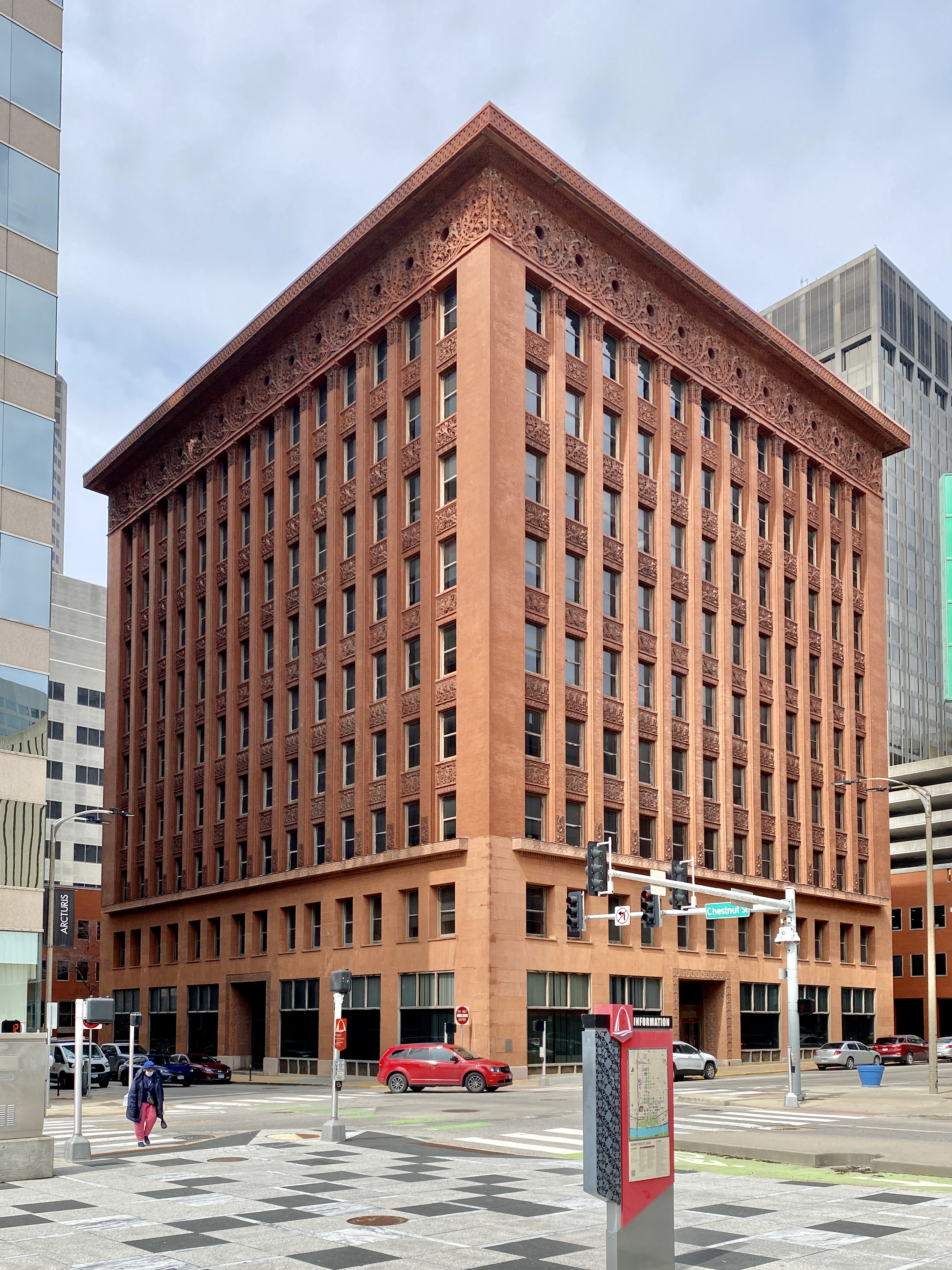
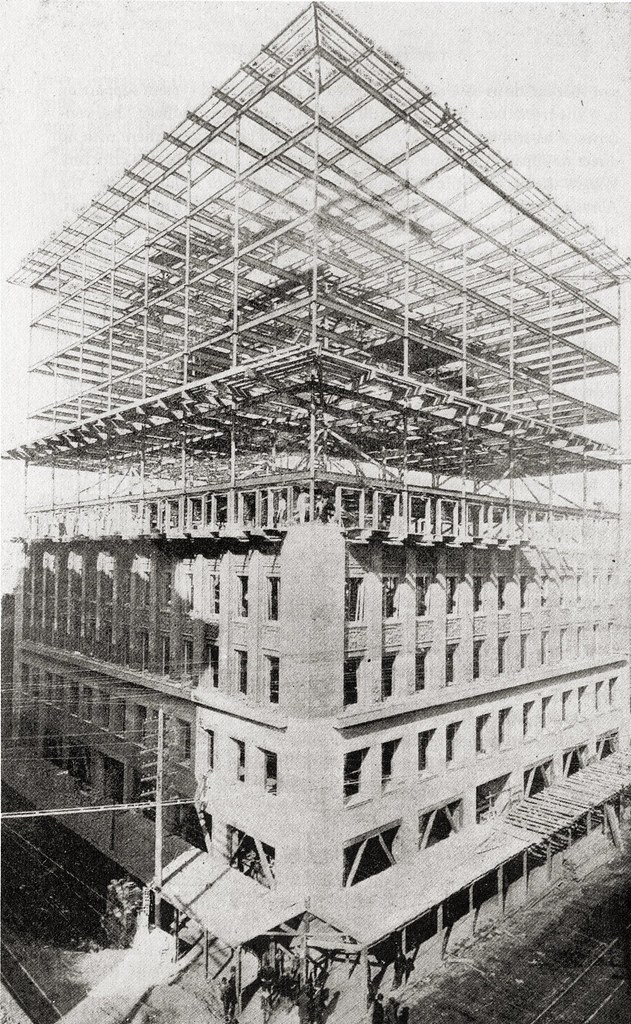 The application of the form follows function principle is most notable in his design of the first skyscrapers. During the late 19th century, as American cities were proliferating, there was a need for taller buildings to maximize limited urban space. Sullivan's innovative approach to skyscraper design included a steel skeleton structure, allowing for taller and more efficient buildings. His Wainwright Building (built to house the Saint Louis Brewers Association) was completed in 1891; it is a prime example of this approach. The building's exterior reflects its internal organization.
The application of the form follows function principle is most notable in his design of the first skyscrapers. During the late 19th century, as American cities were proliferating, there was a need for taller buildings to maximize limited urban space. Sullivan's innovative approach to skyscraper design included a steel skeleton structure, allowing for taller and more efficient buildings. His Wainwright Building (built to house the Saint Louis Brewers Association) was completed in 1891; it is a prime example of this approach. The building's exterior reflects its internal organization.
Sullivan's influence extended beyond individual buildings and the development of the modern skyscraper. He wrote extensively on architectural theory and practice, sharing his ideas and philosophies with the world. His book, "A System of Architectural Ornament," remains a valuable resource for architects and designers, providing insight into his artistic vision. (Sadly, the book is out of print, though it is readily available in PDF form online.)
Sullivan's emphasis on functionality extended to furniture design. He believed furniture should be designed with the user's needs in mind. This view coincided with the shift in furniture design in post-Victorian America and marked a significant departure from the ornate and heavily embellished styles of the time.
Speaking about the shift away from the Victorian era, I’d be remiss if I didn’t remark on Edith Wharton and Odgen Codman’s groundbreaking book, “The Decoration of Houses.” Though there is no documentation I could find on Wharton being influenced by Sullivan, it is easy to imagine how Sullivan’s views informed Wharton and Codman’s perspective on post-Guilded Age rooms.
Years later, the Arts and Crafts movement originated in England but found a strong following in America and was pivotal in shaping post-Victorian furniture design. Advocates of this movement, such as Gustav Stickley, believed in the value of handcrafted, well-made furniture. They embraced natural materials, simple lines, and an emphasis on the inherent beauty of wood grains. Mission-style furniture, characterized by its clean lines and geometric forms, became a hallmark of this movement.
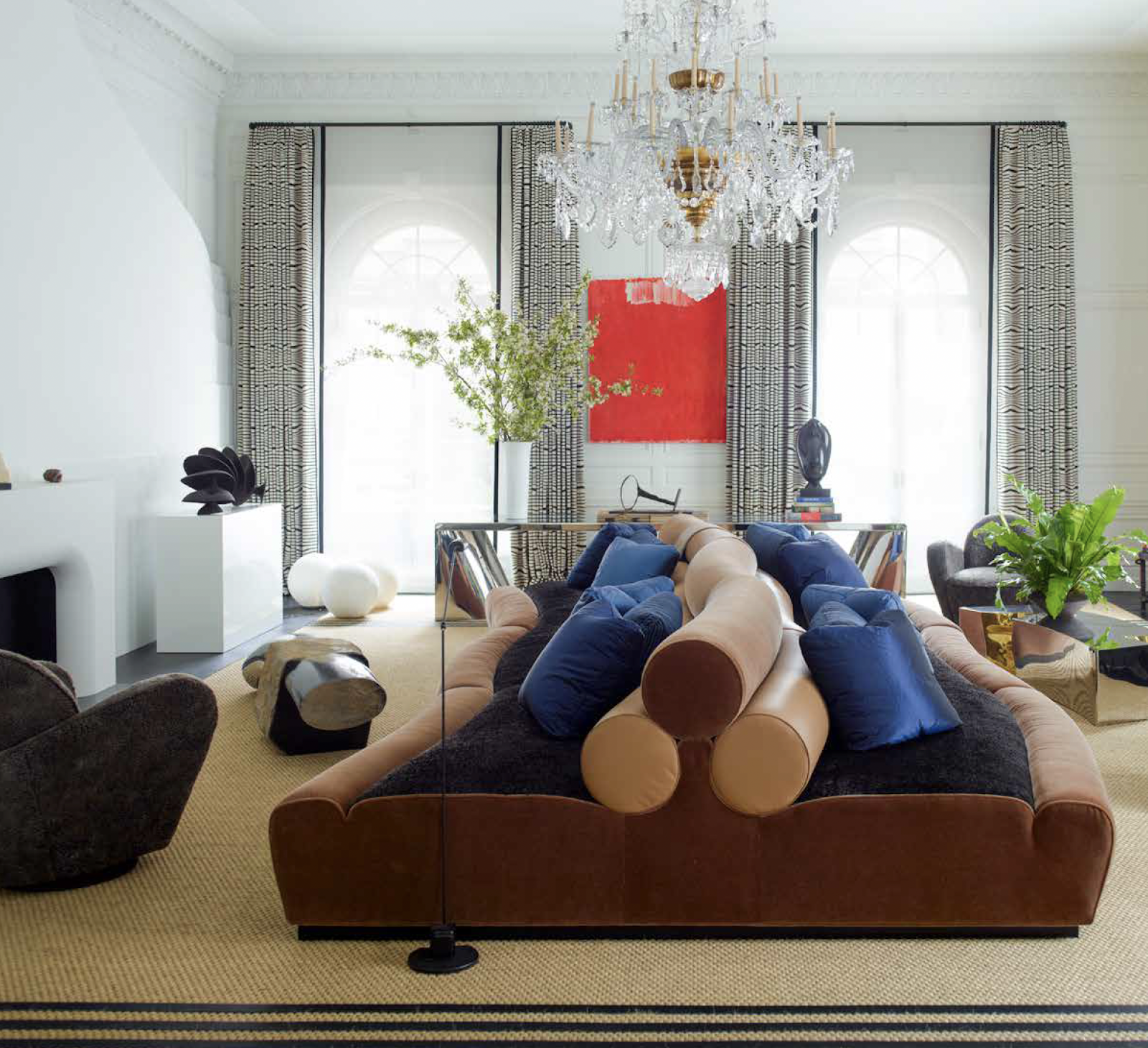
Legendary designer Juan Montoya envisioned a seventeen-foot-long, double-sided serpentine sofa scaled for a reception room in this New York’s Upper East Side mansion. Its form divides the room into two seating areas, which humanizes the grand-scaled space. Shearling-covered club chairs and a sculptural stainless steel desk add to the airy drama. The red painting, Choir, is by British artist Christopher Le Brun—photo credit Eric Piasecki, appearing in Interior Design Master Class from Rizzoli New York.
The shift in furniture design also aligned with broader societal changes, and the early 20th century brought about industrialization and urbanization, which led to smaller living spaces. As a result, furniture needed to be more compact and efficient. Designers like Frank Lloyd Wright (once an underling at Sullivan’s architecture firm) began creating furniture that was not only aesthetically pleasing but also practical for modern living.
Mass production revolutionized furniture design in the 1940s and 1950s, defining an era that emphasized accessibility, functionality, and sleek details. During this period, midcentury modern design arrived, celebrating clean lines and organic shapes.
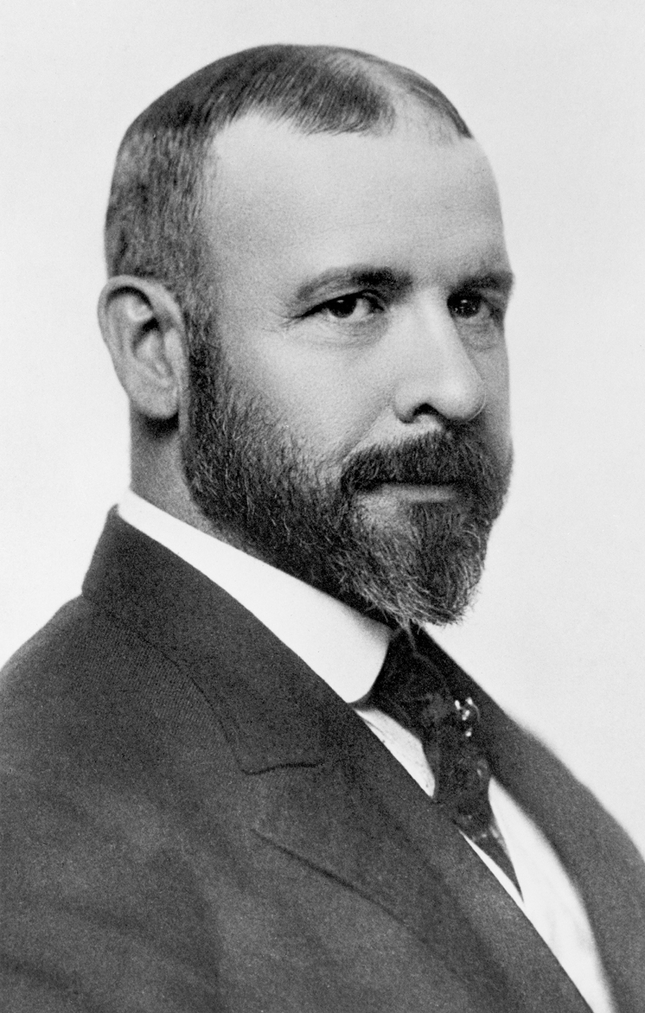 Furniture designers like Charles and Ray Eames, Eero Saarinen, and George Nelson embraced mass production methods, particularly molded plywood and fiberglass. These techniques enabled the efficient creation of iconic pieces such as the Eames Lounge Chair and the Tulip Table. Assembly manufacturing made these designs affordable and readily available, democratizing access to stylish, well-crafted furniture. It is easy to see how these designers put the function of their pieces at the conceptual forefront–to my mind, a nod to Louis Sullivan.
Furniture designers like Charles and Ray Eames, Eero Saarinen, and George Nelson embraced mass production methods, particularly molded plywood and fiberglass. These techniques enabled the efficient creation of iconic pieces such as the Eames Lounge Chair and the Tulip Table. Assembly manufacturing made these designs affordable and readily available, democratizing access to stylish, well-crafted furniture. It is easy to see how these designers put the function of their pieces at the conceptual forefront–to my mind, a nod to Louis Sullivan.
In the 21st century, Sullivan’s principles resonate strongly in sustainable architecture, where functionality and environmental considerations have become paramount. Contemporary interior designers continue to be influenced, too, evidenced by how designers organize floor plans to respond to activities and tasks and how furnishings are tailored for suitability and comfort.
While Sullivan died in 1924, nearly a century ago, his legacy reminds us that three simple words, form follows function, continue to shape architecture and design, facilitating and enriching our modern lives.
Stay updated on this series author, Carl Dellatore, by following his Instagram
About Carl Dellatore & Associates - provides designers, architects, and creatives with writing, editing, and copyediting services by an established team to effectively reveal your story. No Regrets About Her Path to Design
By Lindsay Field Penticuff
It’s been a decade since Paloma Contreras “hung up her shingle” as Director of Marketing at Visual Comfort and started her own design firm—Paloma Contreras Design.
But her professional journey didn’t exactly begin within the interior design industry, even though she recalls being drawn to beautiful things and having an appreciation for design from a very young age.
“I just didn’t know that [interior design] was or that it could be a career,” Contreras admits. “My first career was actually as a high school Spanish teacher, and it was in that career that I realized I was feeling really creatively stifled and I wanted to pursue something else that would heed my creative soul.”
So around 2007, when Contreras’ teaching career was winding down and she was trying to find something to do that would feed her creativity professionally, she started an online blog—La Dolce Vita—and it sort of became her entre into the design universe. She “retired” the blog last year after 15 years.
“I became completely passionate about design and sought out as much information and knowledge as I could,” she says.
Contreras landed a job working as Director of Marketing for Visual Comfort, the lighting manufacturer, and helped launch their Aerin Collection.
After a few years with Visual Comfort, however, she still had a passion for designing for clients, so she took a leap of faith and founded Paloma Contreras Design, which is headquartered in Houston, Texas. This year marks her 10th year running the design firm.
We had the pleasure of interviewing Contreras recently and wanted to share it with you, our members. She tells us more about what inspires her, advice she has for anyone looking to change careers like she did and the process her team follows when working with a client. Enjoy!
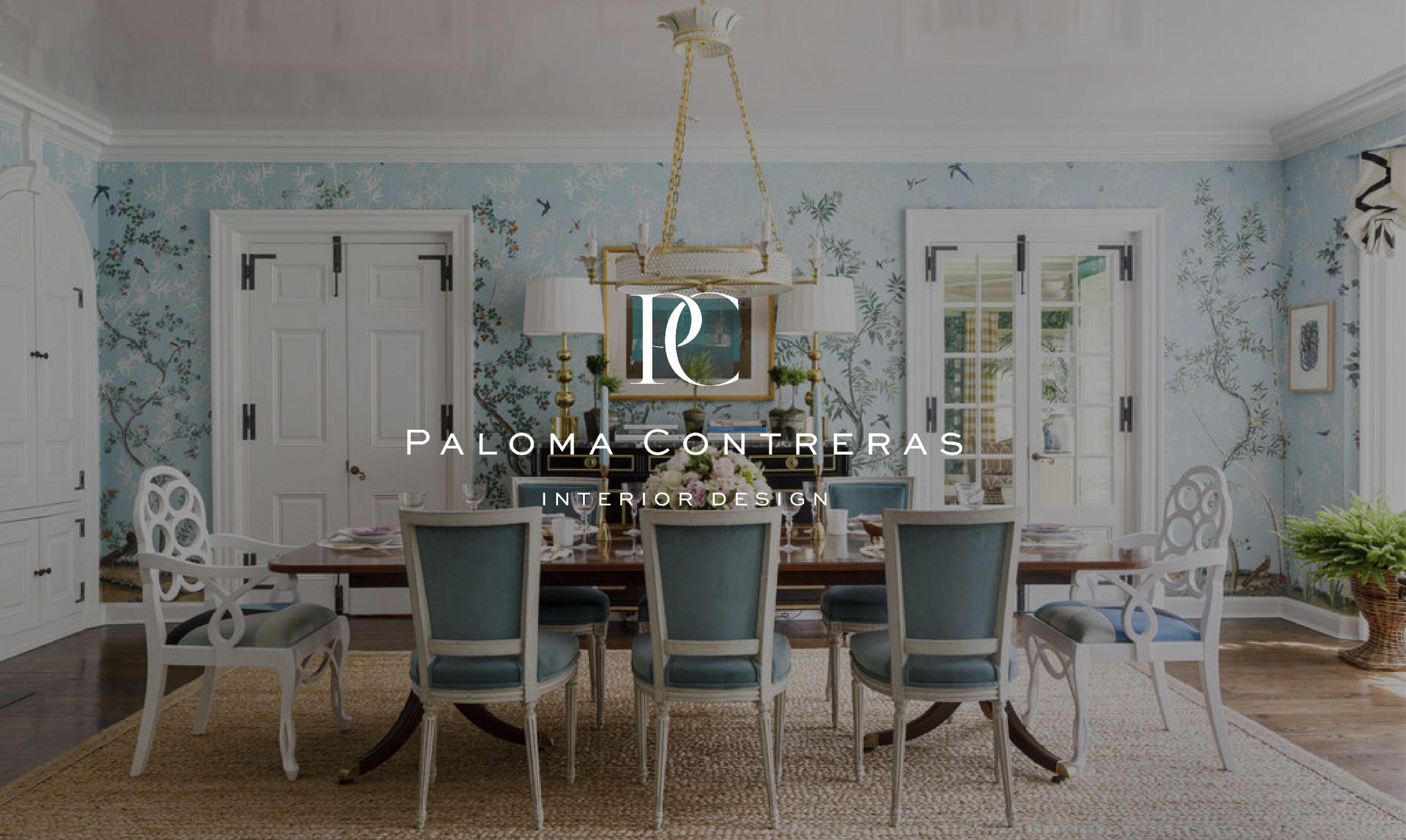
Were you nervous or scared about changing careers?
“I was very excited to pursue my passion. I was also really scared, because I didn’t have a formal background or education in design and I was taking this really big leap. … But because of my blog, I had developed a lot of close relationships with people who had become mentors to me and who had been designing for much longer.”
Do you have any regrets about not pursuing a career in interior design earlier?
“I have no regrets about my path. I just wish I had realized earlier in my life where I was meant to be, because I absolutely would have pursued a designed education and would have absolutely gone to work for other people.”
Has travel enriched your design aesthetic?
“Absolutely! I have not been traveling as much as I once did, but travel feeds my soul in a way that few other things can. I think it’s really important to get out of our day-to-day routine and see different things. Traveling teaches you to see. It also teaches you about different architectural influences, different materials and different details, so for me, it’s always a super enriching experience.”
What’s your favorite place to visit?
“One place that’s been super pivotal and formative in my own work and my own experience as a designer is France, specifically Paris. The art center there and history there, all of those things—that’s where I learned to love antiques. It’s had a huge influence.”
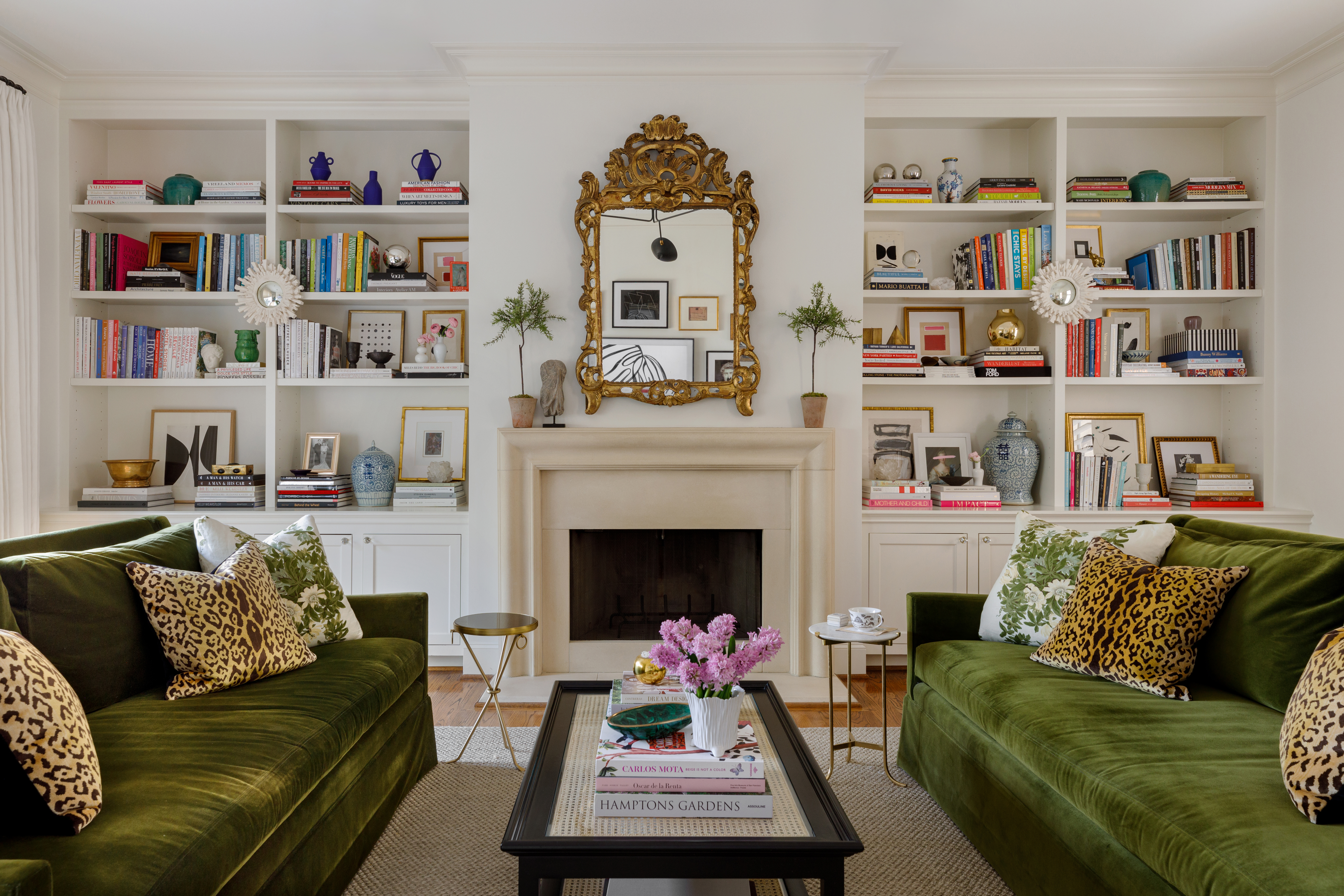 What is your process for designing for a client? Is it a similar formula?
What is your process for designing for a client? Is it a similar formula?
“We start with our onboarding process. There’s usually a discovery meeting, in which we like to meet in our office. It isn’t always possible because a lot of our projects are in other cities, but it’s amazing to be able to have a client come to our studio, meet with the team, walk through our design process and the different phases, have an opportunity to look through our library and pull things at random that sort of resonate with them and that they love, which helps us understand their aesthetic a little bit.
“We have a pretty extensive client profile that we work on with the client in the very beginning as well to get to know them. From there, in terms of the design itself, we start with furniture plans and floor plans. We start building our color pallet and color schemes, putting together the mood and vibe. We’ll present that to the client before we move on into the full design presentation with all of the finishes and furnishings.”
What/Who are some of your most significant influences?
“There are so many things that influence a designer’s work, and for me, specifically, and as cliché as it sounds, travel was one of those big things. I also love to revisit some of my favorite books and the works of iconic designers in the past who have had a big influence on me—Billy Baldwin, Albert Hadley, Frances Elkins, David Adler. You go back to the greats of the past, because if something is going to be timeless, to be able to see how that materializes is really important and helpful as a modern-day designer. … Your peers are also your influences. We’re all spending time on Instagram and constantly scrolling, so you see things that are beautiful and inspiring, and sometimes you can find a way to use that fabric or make that detail your own.”
How do you go about breathing new life into traditional pieces?
“The biggest key is creating a sense of tension, and that’s what adds a bit of freshness to an otherwise very classic or traditional interior. You can have the most traditional upholstery silhouettes and have antiques in a space. You can bring in all these things that are classic and have been around for a long time, but it’s that juxtaposition or tension that I really think makes a room special and makes it seem fresh. Usually, I’ll do that through the addition of an interesting or more modern light fixture, or modern, more abstract art, an interesting textile and unexpected color pallet. Those are all ways of making the classics feel new.”
Tell us more about your new book. When will this be available?
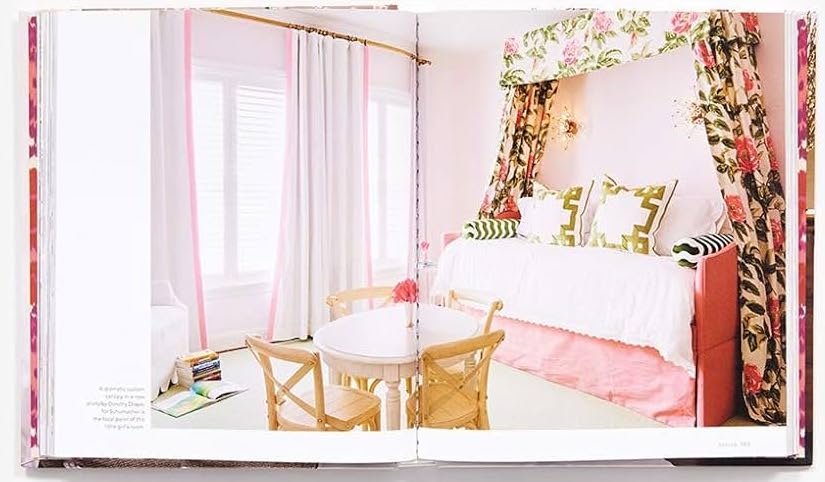 “The title is The New Classic Home, a Modern Take on Traditional Interiors, and was published by Abrams in October. It’s essentially an extension of my first book, Dream, Design, Live, in which we take a deeper dive into the concept of bridging the gap between the seemingly more modern elements and those that are super classic to create a home that feels both timeless, but of the moment. We talk a lot about how to achieve that.”
“The title is The New Classic Home, a Modern Take on Traditional Interiors, and was published by Abrams in October. It’s essentially an extension of my first book, Dream, Design, Live, in which we take a deeper dive into the concept of bridging the gap between the seemingly more modern elements and those that are super classic to create a home that feels both timeless, but of the moment. We talk a lot about how to achieve that.”
What have been some of your most significant obstacles?
“A big challenge for me over the years as my firm has grown, has been saying ‘no.’ When you’re young and early on in your career, you say ‘yes’ to whatever comes your way because you need the work and the images for your portfolio. My nature, and for more women especially, is to want to please and help everyone. After working with a business coach, I’ve learned to be strict and say ‘no’ to things that are not an absolute fit for our firm.”
With regard to social media, how do you choose what to post and share?
“It’s still really organic for me. I’ve done my own social media forever. I’ve never hired anyone to do it on the design side. I post about what am I doing that week, what am I inspired by or whether there is a color pallet that’s on my mind. … Occasionally, I’ll do some cool reels after a photoshoot or install. I do share a little bit of my personal life about my family and my baby. I don’t separate them, because my life is all-encompassing.”
What is your dream project?
“I’d love to do a small boutique hotel somewhere really cool and interesting, and be able to bring to life a vision, lifestyle and vibe or personality to a brand. I think it would be sort of challenging in a different way that designing a home. A home is all about the experience, but it’s so personal. Being able to create a tangible expression of a brand, what they stand for, what their vision is and how that translates into an experience for the guest, I think would be super, super cool.”
What more would you like readers to know about you and/or the firm?
“I have a lighting collection with Visual Comfort that came out last spring (2022), and we have more designs debuting at High Point Market in April. That’s a different way for me to express my creativity, which is different than when you’re designing a home. It’s been really fun to work on product design.”
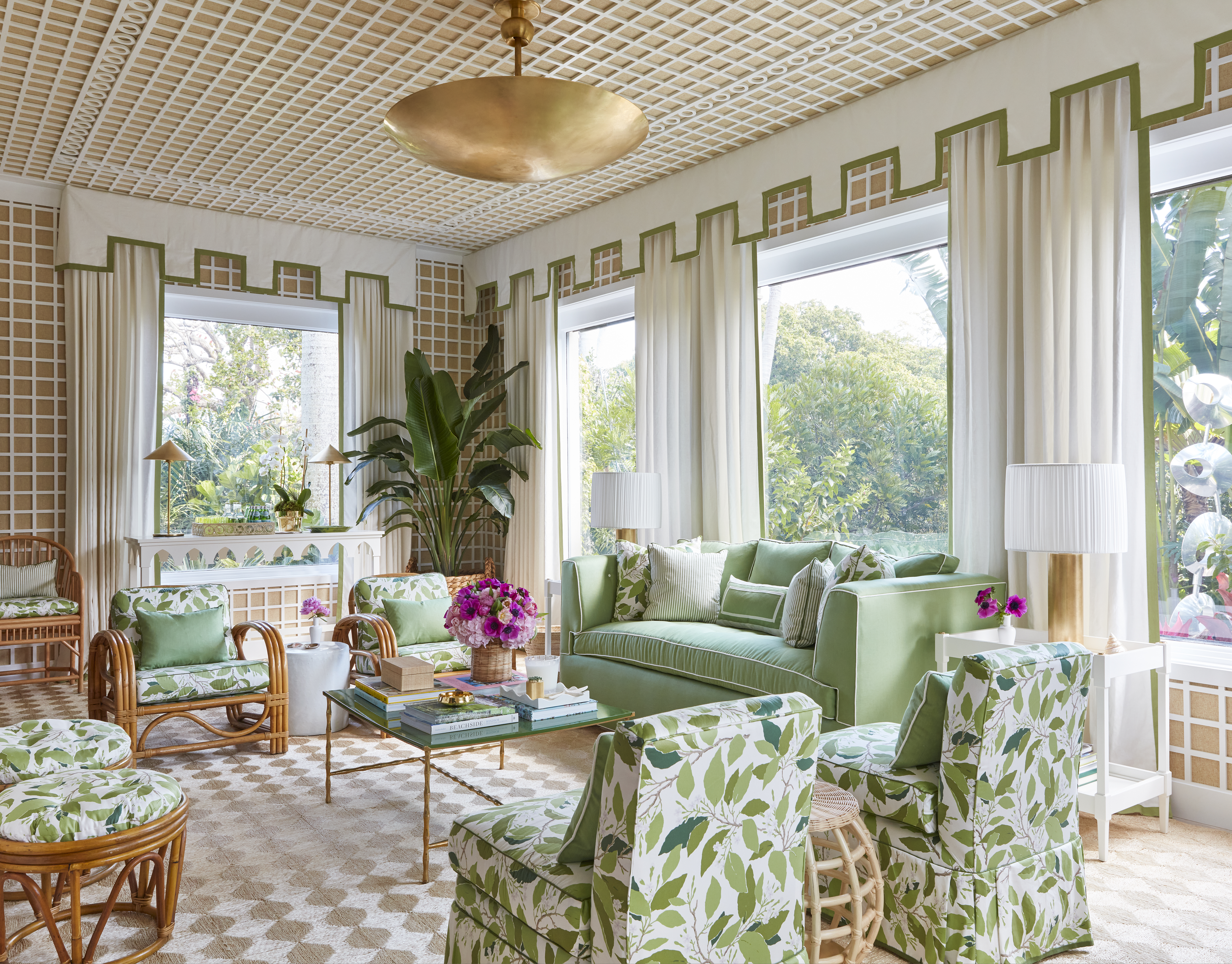
 We’ve all said it or seen it written somewhere that classics never die, and it’s totally true! We see that each and every day in our interior design practices. Oftentimes, when we can’t figure out how to best create a new space, we go back to the classics—How would Dorothy Draper, Mark Hampton or Albert Hadley have done this?
We’ve all said it or seen it written somewhere that classics never die, and it’s totally true! We see that each and every day in our interior design practices. Oftentimes, when we can’t figure out how to best create a new space, we go back to the classics—How would Dorothy Draper, Mark Hampton or Albert Hadley have done this?


.jpg)

 The application of the form follows function principle is most notable in his design of the first skyscrapers. During the late 19th century, as American cities were proliferating, there was a need for taller buildings to maximize limited urban space. Sullivan's innovative approach to skyscraper design included a steel skeleton structure, allowing for taller and more efficient buildings. His
The application of the form follows function principle is most notable in his design of the first skyscrapers. During the late 19th century, as American cities were proliferating, there was a need for taller buildings to maximize limited urban space. Sullivan's innovative approach to skyscraper design included a steel skeleton structure, allowing for taller and more efficient buildings. His 
 Furniture designers like Charles and Ray Eames, Eero Saarinen, and George Nelson embraced mass production methods, particularly molded plywood and fiberglass. These techniques enabled the efficient creation of iconic pieces such as the Eames Lounge Chair and the Tulip Table. Assembly manufacturing made these designs affordable and readily available, democratizing access to stylish, well-crafted furniture. It is easy to see how these designers put the function of their pieces at the conceptual forefront–to my mind, a nod to Louis Sullivan.
Furniture designers like Charles and Ray Eames, Eero Saarinen, and George Nelson embraced mass production methods, particularly molded plywood and fiberglass. These techniques enabled the efficient creation of iconic pieces such as the Eames Lounge Chair and the Tulip Table. Assembly manufacturing made these designs affordable and readily available, democratizing access to stylish, well-crafted furniture. It is easy to see how these designers put the function of their pieces at the conceptual forefront–to my mind, a nod to Louis Sullivan.

 What is your process for designing for a client? Is it a similar formula?
What is your process for designing for a client? Is it a similar formula? “The title is
“The title is 

